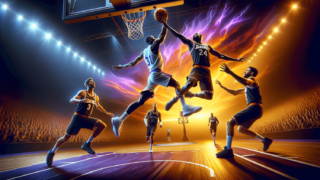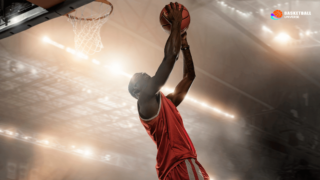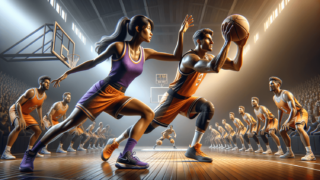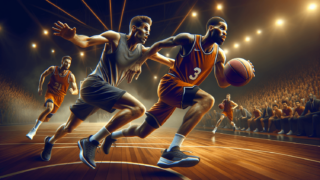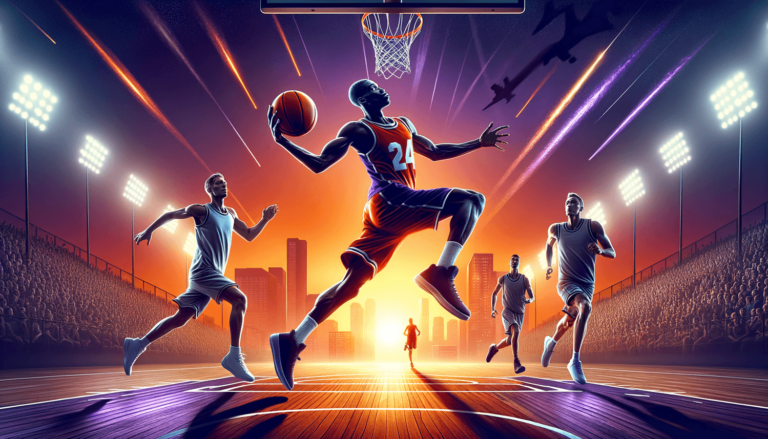
Welcome to our exciting guide on “How to Improve Your Basketball Athleticism!” 🏀. In this blog post, we’ll divulge the secrets to maximizing your physical prowess on the court to help you become a more explosive, quick, and agile player. As basketball enthusiasts ourselves, we understand how vital athletic performance is in this fast-paced game – from jumping high for rebounds to sprinting down the court to defend your opponent. So let’s get down to the nitty-gritty, delve deep into the intricacies of basketball athleticism, and get you well on your way to unleashing your full basketball potential!
How to Improve Your Basketball Athleticism?
Improving your basketball athleticism involves focusing on five key areas: strength, speed, agility, endurance, and flexibility. Develop a tailored workout routine that targets these areas through a mix of exercises such as weight training, plyometrics, speed drills, and cardio sessions. Also, incorporate stretching to maintain flexibility and prevent injuries. Remember to maintain a healthy diet, get sufficient rest, and remain consistent in your training to consistently see improvements in your basketball athleticism.
Develop a Well-Balanced Strength Training Program
Basketball requires strength in both the upper and lower body to effectively execute jumps, shots, and defensive moves. A well-rounded strength training program helps you develop power, control, and muscle stability, making you an athletic powerhouse on the court. Let’s dive into some key exercises that can elevate your basketball performance:
Compound Exercises
Compound exercises work multiple muscle groups simultaneously and are excellent for building functional strength. Incorporate the following exercises into your routine to improve your overall athleticism in basketball:
- Squats: Strengthen leg muscles, glutes, and core.
- Deadlifts: Strengthen the posterior chain, including the hamstrings, glutes, and lower back.
- Bench presses: Develop chest, shoulder, and triceps strength.
- Rows: Boost your upper back, shoulder, and biceps strength.
- Chin-ups or pull-ups: Target lats, biceps, and grip strength.
Core Stability
A strong core is crucial for maintaining stability and balance on the court. Include these exercises in your strength training regimen for a solid core foundation:
- Planks: Help to stabilize and tighten the whole core area.
- Side planks: Strengthen the obliques and lower back.
- Russian twists: Improve rotational strength and coordination.
- Leg raises: Target lower abs and hip flexors.
Explosive and Plyometric Exercises
Explosive and plyometric exercises develop power, quickness, and vertical jump height, which are essential for basketball athleticism. Here are a few prime examples:
- Box jumps: Jump onto and off a plyometric box, focusing on landing softly and exploding back up.
- Broad jumps: Increase your horizontal jumping ability by leaping forward from a stationary position.
- Depth jumps: Step off a box, land on both feet, and immediately jump as high as possible.
- Weighted or med-ball slams: Develop upper body explosiveness by forcefully slamming a medicine ball or weight to the ground.
Cultivate Speed, Agility, and Quickness
Speed, agility, and quickness are crucial for optimal basketball performance. Incorporate these drills and exercises into your training to enhance your court mobility:
Sprint Drills
Sprints help build leg strength, endurance, and speed on the court. Incorporate various sprint drills into your training, such as:
- Line sprints: Sprint from the baseline to the free throw line, back to the baseline, then to the half-court line, and back.
- Shuttle runs: Set up cones at different distances, sprint to each cone in succession, and change direction quickly.
- Hill sprints: Choose a short, steep hill and sprint up and down at maximum effort for an intense workout.
Agility Drills
Agility drills focus on improving lateral and multi-directional movement, foot coordination, and change of direction. Here are a few examples:
- Zigzag drills: Set up cones in a zigzag formation and weave through them quickly, maintaining control.
- Defensive slides: Assume a defensive stance and slide laterally side-to-side, maintaining balance and quickness.
- T-drills: Set up cones in a T-shape and sprint forward, laterally, and backward while changing direction rapidly.
Jump Rope Training
Jumping rope is a simple yet highly effective way to improve foot coordination, quickness, and balance. Try different techniques and jump rope drills to keep things fresh and challenging:
- Single-leg jumps: Jump over the rope with one leg, alternating legs every few jumps.
- Double unders: Pass the rope under your feet twice per jump, increasing coordination and intensity.
- High knees: Drive your knees up towards your chest as you jump, working on explosive power and quickness.
Build Endurance for Continuous Action
Endurance is vital for maintaining peak performance throughout a basketball game. Engage in cardio workouts and practices that help develop your aerobic and anaerobic endurance:
Interval Training
Interval training alternates between high-intensity and low-intensity exercises. This approach mimics the demands of a basketball game and can significantly increase your overall endurance:
- High-intensity interval training (HIIT): Perform short bursts of maximum effort exercises followed by brief recovery periods. Examples include sprints, jump squats, or burpees.
- Circuit training: Complete a series of exercises with little rest between each one. Create a circuit that combines cardio exercises with strength exercises for an efficient full-body workout.
Steady-State Cardio
Adding steady-state cardio exercises such as jogging, swimming, or cycling will help develop your aerobic base and complement your high-intensity training. Aim for 30-45 minutes of steady-state cardio at least 2-3 times a week.
Enhancing Flexibility for a Greater Range of Motion
Flexibility plays an essential role in injury prevention and mobility on the basketball court. Incorporate stretching exercises into your daily routine to augment your flexibility:
Dynamic Stretching
Dynamic stretching involves active movements that slowly increase your range of motion. Perform these stretches before your workout or basketball practice:
- Leg swings: Swing your leg forward and backward while maintaining balance and control. Repeat on both sides.
- Arm circles: Rotate your arms in small, medium, and large circles to loosen up the shoulders and upper back.
- Walking lunges with a twist: Step forward into a lunge and rotate your upper body to stretch the hips and torso.
Static and PNF Stretching
Static and proprioceptive neuromuscular facilitation (PNF) stretching involve holding the stretch for a specific amount of time to increase flexibility. Perform these stretches after your workout or basketball practice:
- Hamstring stretch: Sit on the floor, extend one leg forward, and bend the other leg inward. Reach towards the extended leg’s toes and hold the stretch.
- Quad stretch: While standing, pull one foot up towards your glutes, gently stretching the front of your thigh. Repeat on the other leg.
- Piriformis stretch (PNF): Lie on your back, cross one ankle over the opposite knee, and gently pull the knee in to stretch the glutes and hips. Hold the stretch, then contract for a few seconds before relaxing and pulling the knee back.
Armed with these actionable tips, you can transform your basketball athleticism and be the force to reckon with on the court! Be consistent, work hard, and have fun experimenting with various workouts to find what suits you best. With determination and discipline, you’ll notice significant improvements over time, helping you stand out in the basketball world.
Implement Sports-Specific Drills and Techniques
Aside from developing your athletic abilities, honing your basketball-specific skills is crucial to becoming a more effective player. Enhance your basketball athleticism by incorporating drills that emulate game situations and refine your on-court abilities:
Ball Handling Drills
Practice your dribbling and ball-handling skills with various drills that improve your control, speed, and coordination, thereby boosting your basketball athleticism. Some of these drills include:
- Two-ball dribbling: Dribble two basketballs simultaneously, alternating or in sync, to increase hand-eye coordination.
- Figure-eight dribbles: Dribble the ball around and between your legs in a figure-eight pattern to build control and fluidity.
- Spider dribble: With a low, rapid dribble, move the ball between your hands, passing it through your legs and around your body.
Shooting Drills
Master various shot types in basketball to become a versatile and effective scoring threat. Incorporate shooting drills that challenge your shot-making skills at different positions and situations:
- Spot shooting: Pick several key spots on the court, and practice taking shots from those positions to develop your scoring instincts.
- Off-the-dribble shooting: Begin with a dribbling move and transition into a jump shot quickly, making sure to maintain proper form and balance as you shoot.
- Mikan drill: Stand next to the hoop, and practice making short layups using quick footwork and alternating hands, simulating the rhythm of fast breaks.
Defensive Drills
Boost your defensive abilities by incorporating drills that develop your footwork, positioning, and court awareness. Implement defensive drills such as:
- Closeout drill: Start from the key, and quickly close out on an imaginary offensive player, mimicking a defensive stance with hands up and active feet.
- Box-out drill: Assume a rebounding position and practice boxing out a partner, focusing on maintaining correct body positioning and footwork.
- Interception drill: Work on reading and anticipating passes by positioning yourself between two teammates and attempting to intercept their passes.
Focus on Nutrition and Recovery
Proper nutrition and recovery play significant roles in improving your basketball athleticism. Adopt a holistic approach to your training by considering these essential components:
Proper Nutrition
A balanced diet fuels your body, providing the energy and nutrients required to optimize your athletic performance. Key nutritional guidelines for basketball players include:
- Consume a diet rich in carbohydrates for energy, lean proteins for muscle repair, and healthy fats for essential fatty acids.
- Stay hydrated throughout the day, and replenish fluids lost during physical activity with water or electrolyte-packed sports drinks.
- Avoid processed, high-sugar, and high-fat foods, as they can negatively impact your energy levels and overall health.
Adequate Rest and Recovery
Rest and recovery are crucial for preventing injuries, reducing fatigue, and promoting muscle growth. To ensure proper recovery, adhere to the following principles:
- Get at least 7-9 hours of sleep per night to give your body ample time to repair and rebuild muscle tissues.
- Include rest days in your training schedule, allowing your muscles to recover and rebuild between workouts.
- Partake in active recovery, such as foam rolling or yoga, to alleviate muscle soreness and increase flexibility.
By engaging in sports-specific drills, focusing on nutrition and recovery, and incorporating the tips provided earlier, you’ll create a comprehensive approach to improving your basketball athleticism. Stay consistent, and continually refine your skills to become an unstoppable force on the basketball court.
Frequently Asked Questions About Basketball Athleticism
In this FAQ section, we’ve compiled a list of common questions and concise answers related to improving your basketball athleticism. These answers are structured to provide further insights and understanding while complementing the information provided in the blog post.
1. How long does it usually take to see improvements in basketball athleticism?
Improvements in basketball athleticism generally depend on the individual’s current fitness level, commitment, and consistency in their training regimen. Generally, noticeable progress occurs within 4-6 weeks, although it’s important to set realistic expectations and understand that significant advancements might require months or years of consistent training.
2. Can I improve my vertical jump for basketball?
Yes, you can improve your vertical jump for basketball through a combination of plyometric exercises, strength training, and flexibility exercises. These will help develop your lower body explosive power, which is vital for enhancing your vertical jump.
3. How often should I train to improve my basketball athleticism?
It’s recommended to train at least 3-5 days per week, dedicating time to strength training, conditioning, and sport-specific drills. Balancing the intensity of your workouts with adequate rest and recovery is crucial for promoting progress and preventing injuries.
4. Can younger athletes work on basketball athleticism?
Definitely! Younger athletes can build a solid foundation in basketball athleticism through age-appropriate exercises focusing on bodyweight strength, fundamental movement skills, and basic sport-specific drills. Always ensure the training is safe and supervised by an experienced coach when working with young athletes.
5. What is the most crucial aspect of basketball athleticism?
There isn’t one specific aspect that stands out as the most crucial. Basketball athleticism is a combination of strength, speed, agility, endurance, and flexibility. All of these elements are essential for overall improvement and should be addressed in any training program.
6. Can I improve my basketball athleticism without access to a gym?
Yes, you can improve your basketball athleticism without gym access. Many effective exercises, such as bodyweight exercises, plyometrics, and agility drills, can be performed with minimal equipment. Additionally, implementing outdoor running, basketball-specific drills, and stretching can help boost your athleticism.
7. How important is flexibility for basketball athleticism?
Flexibility is crucial for basketball athleticism as it enables a greater range of motion, improved body control, and reduced risk of injury. Incorporating a consistent stretching routine can enhance your flexibility, ultimately contributing to overall basketball athleticism.
8. What role does nutrition play in improving basketball athleticism?
Nutrition plays a vital role in fueling your body for optimal performance, providing the necessary energy and nutrients for efficient training and recovery. A balanced diet rich in carbohydrates, lean proteins, and healthy fats supports muscle growth, repair, and overall health, enabling continuous progress in basketball athleticism.
9. How can I test my basketball athleticism progress?
You can test your basketball athleticism progress through various fitness tests, such as vertical jump tests, shuttle run agility tests, and sprint tests. Regularly tracking your progress can provide valuable insights into the effectiveness of your training program and help identify areas for improvement.
10. How can I stay motivated to improve my basketball athleticism?
Staying motivated to improve your basketball athleticism involves setting realistic goals, maintaining a consistent training schedule, and tracking your progress. Engage in rewarding, enjoyable workouts and drills that challenge you, and don’t forget to celebrate your achievements as you progress toward becoming a more athletic basketball player.
Featured Posts
- No pillar pages found.
